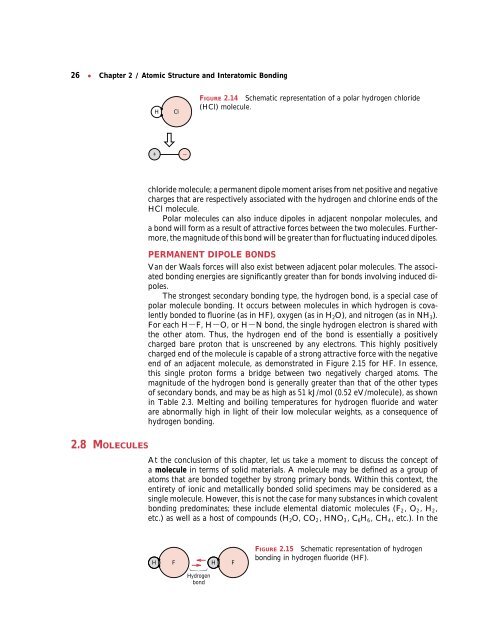Chapter 2 / Atomic Structure and Interatomic Bonding
Chapter 2 / Atomic Structure and Interatomic Bonding
Chapter 2 / Atomic Structure and Interatomic Bonding
Create successful ePaper yourself
Turn your PDF publications into a flip-book with our unique Google optimized e-Paper software.
26 ● <strong>Chapter</strong> 2 / <strong>Atomic</strong> <strong>Structure</strong> <strong>and</strong> <strong>Interatomic</strong> <strong>Bonding</strong><br />
2.8 MOLECULES<br />
+<br />
H<br />
Cl<br />
<br />
FIGURE 2.14 Schematic representation of a polar hydrogen chloride<br />
(HCl) molecule.<br />
chloride molecule; a permanent dipole moment arises from net positive <strong>and</strong> negative<br />
charges that are respectively associated with the hydrogen <strong>and</strong> chlorine ends of the<br />
HCl molecule.<br />
Polar molecules can also induce dipoles in adjacent nonpolar molecules, <strong>and</strong><br />
a bond will form as a result of attractive forces between the two molecules. Furthermore,<br />
the magnitude of this bond will be greater than for fluctuating induced dipoles.<br />
PERMANENT DIPOLE BONDS<br />
Van der Waals forces will also exist between adjacent polar molecules. The associated<br />
bonding energies are significantly greater than for bonds involving induced dipoles.<br />
The strongest secondary bonding type, the hydrogen bond, is a special case of<br />
polar molecule bonding. It occurs between molecules in which hydrogen is covalently<br />
bonded to fluorine (as in HF), oxygen (as in H2O), <strong>and</strong> nitrogen (as in NH3). For each HUF, HUO, or HUN bond, the single hydrogen electron is shared with<br />
the other atom. Thus, the hydrogen end of the bond is essentially a positively<br />
charged bare proton that is unscreened by any electrons. This highly positively<br />
charged end of the molecule is capable of a strong attractive force with the negative<br />
end of an adjacent molecule, as demonstrated in Figure 2.15 for HF. In essence,<br />
this single proton forms a bridge between two negatively charged atoms. The<br />
magnitude of the hydrogen bond is generally greater than that of the other types<br />
of secondary bonds, <strong>and</strong> may be as high as 51 kJ/mol (0.52 eV/molecule), as shown<br />
in Table 2.3. Melting <strong>and</strong> boiling temperatures for hydrogen fluoride <strong>and</strong> water<br />
are abnormally high in light of their low molecular weights, as a consequence of<br />
hydrogen bonding.<br />
At the conclusion of this chapter, let us take a moment to discuss the concept of<br />
a molecule in terms of solid materials. A molecule may be defined as a group of<br />
atoms that are bonded together by strong primary bonds. Within this context, the<br />
entirety of ionic <strong>and</strong> metallically bonded solid specimens may be considered as a<br />
single molecule. However, this is not the case for many substances in which covalent<br />
bonding predominates; these include elemental diatomic molecules (F 2,O 2,H 2,<br />
etc.) as well as a host of compounds (H 2O, CO 2, HNO 3,C 6H 6,CH 4, etc.). In the<br />
H<br />
F<br />
Hydrogen<br />
bond<br />
H<br />
F<br />
FIGURE 2.15 Schematic representation of hydrogen<br />
bonding in hydrogen fluoride (HF).



